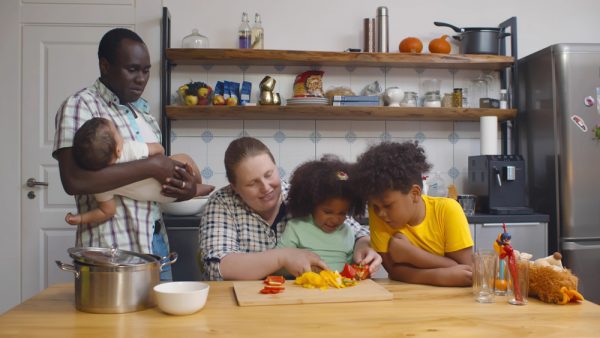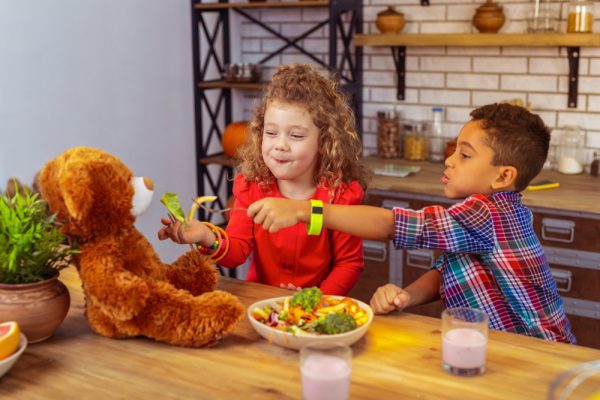
[ad_1]

Making a welcoming and inclusive household dinner atmosphere typically means coping with the results of trauma. Childhood trauma is extra widespread than many mother and father understand; over 60% of adults report having skilled a number of Antagonistic Childhood Experiences (ACEs). Whereas not each one that experiences an ACE will go on to exhibit the signs of trauma, many will. And for kids who’ve skilled ACEs akin to abuse or neglect, meals insecurity, publicity to violence, instability in household life, or power mistreatment associated to a incapacity, the aftereffects of that trauma can negatively impression odd every day rituals like household dinner.
Dr. Martha Straus, psychologist, professor, and creator of Cool, Calm, and Linked, provides that whereas some youngsters are born with feeding challenges associated to neurodivergence, others might develop difficulties with consuming and mealtimes attributable to trauma they’ve skilled. “I largely work with children with complicated developmental trauma – children who had early important adversity of their caretaker relationship,” she explains. “The one that was alleged to be caring for the kid was neglectful or abusive. These are children who’ve anxiousness and despair. They find yourself with feeding points, like issue dealing with utensils, and hoarding meals. They’ve sophisticated relationships to meals.” She additionally provides that sensory processing points are widespread in youngsters who’ve skilled trauma. “These children aren’t built-in,” Straus says. “They’re overwhelmed. It’s not about management a lot as it’s about tactile or sensory defensiveness.”
And it’s not solely children who could also be impacted by trauma on the dinner desk. Dr. Archana Basu, a toddler and household therapist specializing in trauma and post-traumatic stress at Massachusetts Normal Hospital, factors out that intergenerational trauma is an actual concern for households to sort out. “Parental historical past of psychological sickness is among the ACEs,” she explains. “Trauma can have a really broad spectrum impression. In a trauma-informed strategy, we reframe all of the signs to what occurred in that particular person’s historical past that contributed to the signs. Dinnertime might be probably the most difficult time for folks who might have had a tough day, in order that it’s troublesome for them to assist children regulate. Children could be oppositional, and that habits can set off a lot within the mum or dad, relying on their very own historical past.”
Along with ACEs, for some children with studying and developmental challenges, inappropriate expectations at mealtimes can truly trigger trauma. “I contemplate myself an activist,” says Naureen Hunani, RD., a pediatric and household dietitian who makes a speciality of neurodiversity and can be the mom of neurodivergent youngsters. “The kind of youngsters who’ve sensory processing points, and fogeys aren’t knowledgeable about easy methods to assist them – mother and father might stress them to eat meals after they have aversions to these meals, and that may trigger a trauma. Some youngsters have trauma from being in feeding remedy. Neurodivergent youngsters usually tend to expertise trauma as a result of the world isn’t arrange for them.”
On condition that trauma responses at meals are more likely to present up in foster and adoptive households, in addition to with neurodivergent children and another particular person – of any age – who has skilled ACEs, it’s doubtless that many dinner tables are affected by trauma. So what can caregivers do to make dinner really feel protected and welcoming for the entire household?

We spoke with a bunch of consultants in youngster improvement, household remedy, and trauma-informed care. Listed here are their suggestions:
- Hold calm and don’t take it personally. “We deal with children in another way if we take into consideration this as a management concern,” Straus says. “If you consider it as overload, then caregivers will interact with much less emotion. We actually must give attention to adults being regulated at mealtime…As an alternative of claiming that he’s doing it to control or management, use the phrase relationship. What appears to be like like oppositionality or brattiness is the way in which they’re connecting with their caregiver round issues with transitions, anxiousness, or worry.”
- Apply regulating feelings away from the desk first. Each adults and youngsters might have apply to settle down and really feel prepared to have interaction at mealtimes. Straus recommends constructing these expertise outdoors of mealtimes to start with. “Mealtime is so sophisticated for traumatized children as a result of meals is about intimacy and nurture,” she factors out. “There are loads of guidelines right here in civilization!” Earlier than anticipating children (and adults) to make use of regulating methods to deal with their emotions in a mealtime atmosphere, everybody can work collectively to develop some instruments – like deep respiration workouts – they really feel snug utilizing at different instances. “Mother and father can then say on the desk, ‘You’ve practiced this earlier than.’”
- Heal your self. Basu provides that parental modeling is a robust software in serving to the entire household to beat trauma. “We’re extra usually prepared to do for our youngsters what we will’t do for ourselves,” she remarks. “We will construct on the love that oldsters have for his or her children, however the paradox is that it’s onerous to do for teenagers when mother and father haven’t had excellent care. Their wants are important to supporting the ecosystem.” Dr. Basu recommends that oldsters interact in self-care practices, like remedy or self-reflection, that are additionally then an funding of their youngsters. She notes that “Investing in a single’s self is an intergenerational intervention. When mother and father expertise remedy, and might mannequin it, they will present that their children can ask for assist.”
She provides that caregivers will want to concentrate on their very own trauma historical past. “Acknowledge patterns (on the dinner desk)…what does that convey up for you?” she counsels. “I encourage mother and father to mirror on their very own challenges and strengths, and likewise construct on their resilience.” - Construct in light, comforting rituals. “Transition time is at all times troublesome for teenagers in trauma,” Straus says. “Coming to the desk just isn’t really easy for these children. What brings them to the desk gracefully?” She lists concepts like giving comforting hugs earlier than sitting all the way down to eat, singing a favourite tune collectively, standing collectively and stretching, saying grace or itemizing belongings you’re grateful for. However pay shut consideration to how the kid reacts – they might not be prepared for one thing like taking part in a household prayer or gratitude train. “Possibly you might simply maintain palms and breathe collectively,” she suggests.
- Be as predictable as potential. “Any atmosphere that’s sudden goes to be traumatizing,” Straus stresses. “As time goes on, if the atmosphere is protected, dinner will occur. The unknown is what’s scary. For (many) traumatized children, what was sure was hazard and screaming on the desk.”
Basu agrees, giving the instance of a kid who might have witnessed home violence. “That youngster can be hypervigilant at dinner, anticipating that one thing unhealthy goes to occur,” she says. “The blueprint for that youngster is that that is an unsafe time.” However violence or abuse aren’t the one traumatic occasions which may be triggering for teenagers at mealtimes. Basu additionally factors out that when younger youngsters have skilled power neglect and instability, their developmental processes are interrupted. They don’t have the talents and expertise crucial to grasp what an everyday, predictable household meal must be like, or to take part efficiently.
Straus and Basu each stress the significance of making predictability to assist overcome children’ ingrained fears. “That is what we’re going to have,” Straus fashions. “That is the place we’re going to take a seat. How about you select one meals every evening that we will have? When children know what to anticipate, they’ll quickly come to really feel that it’s protected.” - Take the stress off. For a kid who’s struggling to really feel protected at meals, lots of the expectations caregivers would possibly maintain – consuming what’s served, utilizing fundamental manners, taking part in conversations – aren’t cheap. It’s essential to maintain dinner as low-pressure as potential for some time, so children can step by step construct their sense of safety. Expectations round meals and consuming might be significantly tough for individuals who have skilled trauma, Basu says. “Something that’s about management and emotional dysregulation can present up round meals,” she reminds caregivers. Basu additionally brings up the significance of bodily autonomy and bodily security for a traumatized youngster. “What goes into your physique, and who places it in, can result in mealtime challenges.” Caregivers might have to offer children additional enter into what’s served, and make a degree of refraining from commenting on how a lot is eaten or not eaten at meals.
As for dialog and socializing at mealtimes, which may be a talent traumatized children aren’t fairly able to grasp. Till a basis of security and luxury is properly established, anticipating children to have interaction on the desk could also be unreasonable. As an alternative, Straus recommends having the children assist to create a cushty atmosphere. “I feel music is underutilized,” she says. “You might do a DJ factor. Or have somebody accountable for the sensory world – the music, the lighting. Or what if the eating room chairs are too uncomfortable? Possibly they’d be extra cozy on the ground or a sofa.” And Straus encourages caregivers to not ask too many questions in an try to get dialog transferring. “A Q and A might be too intense,” she says. “Grill the meals, not the children!” - Take care of the kid in entrance of you. Above all, when managing the results of trauma at mealtimes, it’s very important to grasp what every member of the family is prepared for – and what they’re not. Dr. Robyn Thom, Youngster and Grownup Psychiatrist on the MGH Lurie Middle for Autism, encourages caregivers to solely contain traumatized youngsters in household meals to the extent that they’re snug. “Possibly the kid might come by the desk for dessert, or to inform a joke or a riddle. Possibly they might sit with the household for as brief as a minute. It’s important to meet the child the place she is.”
Straus agrees, asking bluntly, “Why do we’d like children to eat with somebody? Some children can’t do it.” They are able to take part extra over time, but when a toddler isn’t prepared to have interaction in household mealtimes, nobody will profit from a wrestle.
The underside line is that when trauma impacts the household meal, making a protected and comforting atmosphere is crucial factor – it doesn’t matter what that atmosphere appears to be like like. However over time, with loads of persistence and consistency, it’s potential to construct nurturing mealtime rituals. “Mealtime is such a central illustration of our tradition, traditions, and likewise our distinctive household histories. It represents feeling nourished, calmed, fulfilled, and satiated. It may be a collaborative course of for folks and kids, constructing on their cultural traditions, and household values and rituals,” Basu says. Caregivers can use that collaborative spirit to create a household dinner atmosphere that features, respects, and nurtures everybody.
[ad_2]